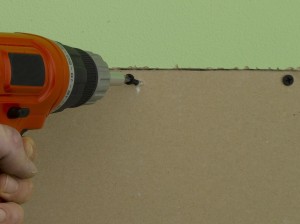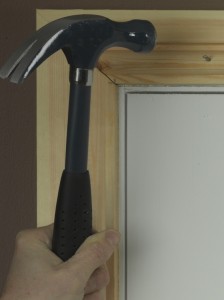Screws or Nails?
Screws or nails for your DIY project? Which do you choose? To be honest, using nails has now become a comparatively rare occurrence, as you can be much more accurate with screws, they are easy to pop in and out if you need to make adjustments, and in most cases, create stronger fixings than nails. Also, one of the main reasons I, and indeed any builder, or DIY enthusiast uses more screws than nails these days is a direct result of the invention, and general uptake of the cordless screwdriver. Effectively, screws can now be inserted much more quickly than a nail, with far less effort.
However, there are still some circumstances where nails can be considered an option, and the guide below picks out the most common jobs around your home that do warrant a little contemplation, before you pick up your hammer and nails, or screws and drill/driver.
Fixing skirting boards
When fixing skirting boards, technique generally depends on whether the wall is masonry or studwork (contains wooden uprights and noggins). You can use masonry nails for block, stone and brick walls but getting a good fixing requires precise ,and indeed strenuous, striking of the nail with the hammer. What you then tend to find is that once you have one good fixing with a masonry nail, the very action of trying to knock in the next nail, causes the previous one to loosen and the skirting “bounces” off the wall. Therefore, using wall plugs and screws is by far the best option. Yes, you need to drill into the wall with a masonry bit, then insert a wall plug, and then insert the screw, but once in place, it’s a firm fixing.
For stud walls, nails can certainly still be used; they are inserted through the skirting into the studs behind, but you may still get some “bouncing” with an uneven wall surface – so screws, again, would be my first choice.
The only drawback to using screws for skirting board is that if you ever have to lever it off, to access pipework for example, it will cause a lot of damage compared to levering off a nailed-on skirting. However, I think that’s a risk worth taking as, in most cases, you’ll never have to remove the skirting.
Fixing architrave
Architrave, is nearly always fixed to the door lining, and therefore nails are really all that is required – lost-head or oval nails are ideal.
You can use screws, but the size of a screw head tends to damage the rounded, ornate parts of the architrave moulding.
Repairing this damage with filler, and sanding, is much more difficult to achieve to a high level of finish, than would be the case if you were just filling and sanding over punched in nail heads.
Also, nails make architraves much easier to pop-off than screws, so there are no real reasons to choose screws over nails here, unless you have uneven walls and really need to “pull” the architrave into place.
Building stud walls
Traditionally, stud walls were knocked together with 100 mm (4in) nails, and many still are, but another power tool, the power nailer, is often used by site carpenters these days.
In DIY terms, I think screws offer a better option as banging nails in with a hammer, often pushes timbers out of vertical. Basically, you can achieve much greater accuracy using 100 mm screws when constructing your studwork.
Flooring
There are so many different types of wooden flooring, it is difficult to have too many hard and fast rules, however, below are a few common examples.
If you have floorboards, that are to be left exposed, then nails are still the most attractive option, and for traditional floors, I would always tend to used cut nails that give that authentic touch. For floorboards that are to be covered with carpet, nails may still suffice, but it is always a good idea to check for any squeaky floorboards and use screws to hold these in place.
Floor sheet materials like tongue and groove green chipboard floor panels are best screwed down, as it holds them tight to the floor joists and helps ensure no creaks when walked across.
Plaster coving and features
Nails are often used as supports under coving lengths (whilst adhesive dries), and then removed once the adhesive has set. However, if the coving manufacturer recommends that mechanical fixing is required to actually hold up the coving, then screws would be the choice for me. Using mechanical fixing is a situation more associated with another type of plaster feature – plaster ceiling roses, where you must use screws to help support it’s weight. Under no circumstances use a hammer and nails with a plaster ceiling rose!
Fixing plasterboard

Always use plasterboard or drywall screws for fixing plasterboard in place……galvanised nails are just soooo last century!
Fixing plasterboard to studwork, can be achieved using galvanised plasterboard nails or drywall screws (commonly black phosphate coated).
However, the only possible excuse for anyone using nails these days, must be price because using screws is so much easier, and ultimately effective.
Basically, plasterboard does not like being hit with a hammer, and so if you are not extremely accurate when inserting the nails, you not only risk damaging the plasterboard with every blow, but also you may not insert the nails far enough, which leads to problems of “popping” nail heads at a later date (especially with ceilings).
Boxing-in
Boxing-in is commonly found around pipework in your home. The key here is to choose fixings that allow access to that pipework for maintenance reasons. Therefore if you uses screws to secure boxing sections, you must leave the heads exposed so that you can unscrew them easily. In other words don’t fill and paint them, or it will cause a lot of damage if you need to remove that particular section of boxing in the future. For this reason, nails may be used in the design so that panels can be easily prised or levered off if necessary.
The information above provides some of the most common situations where you may have a choice between using screws or nails for the job. My guide ‘Household fixings kit’ will provide you with some further information on the types of fixing available.

